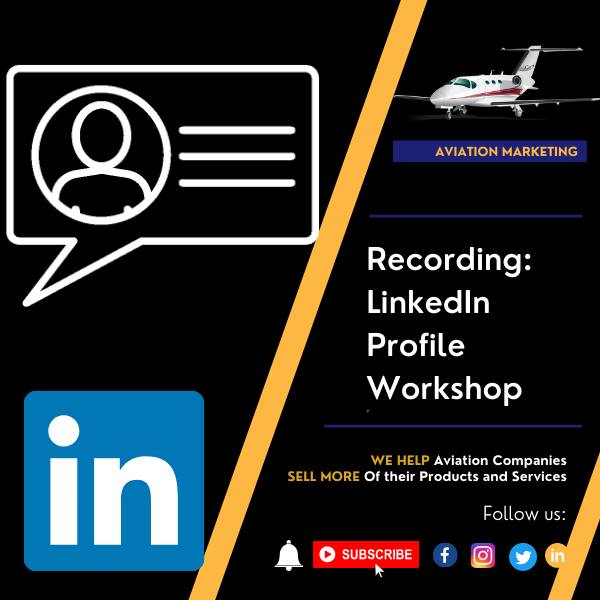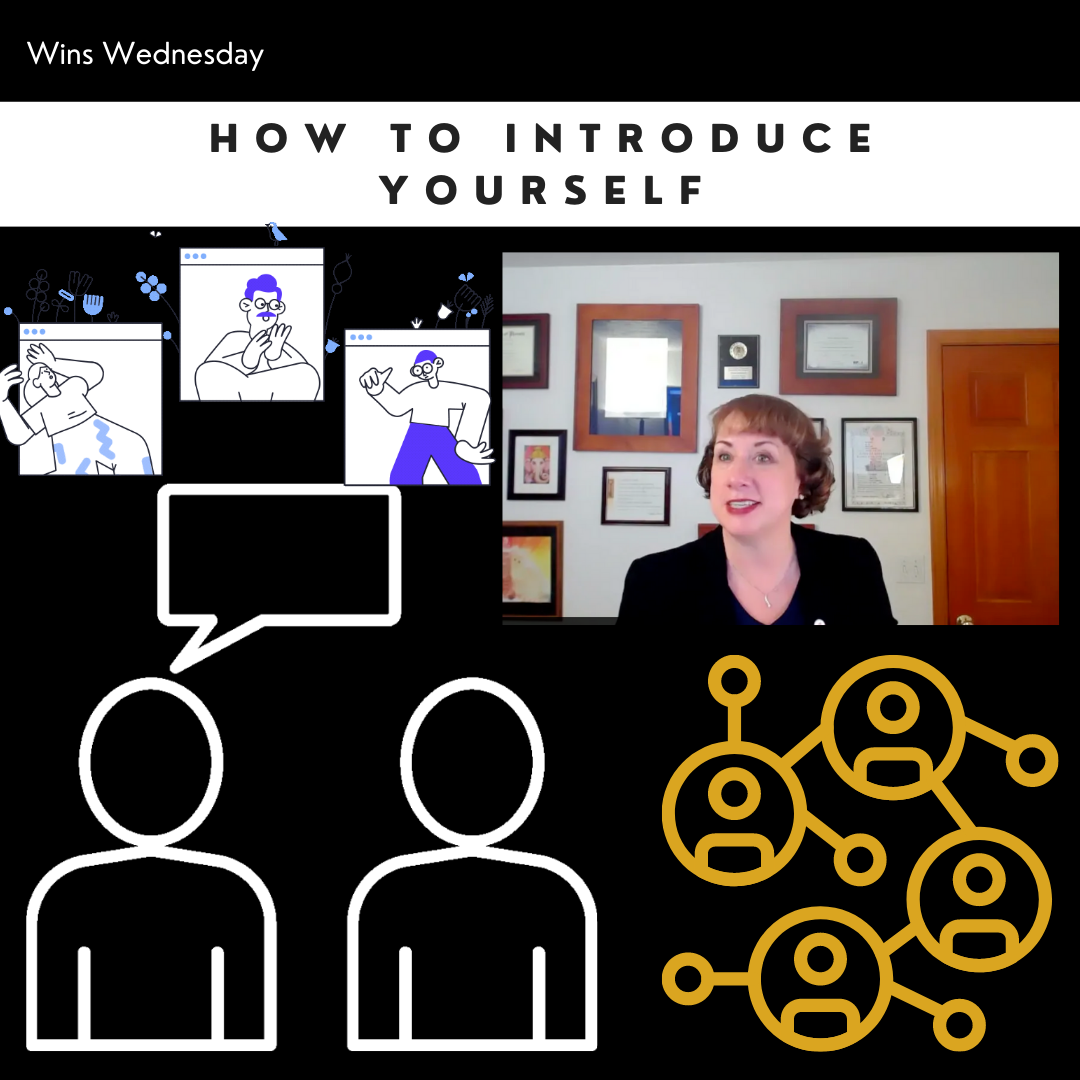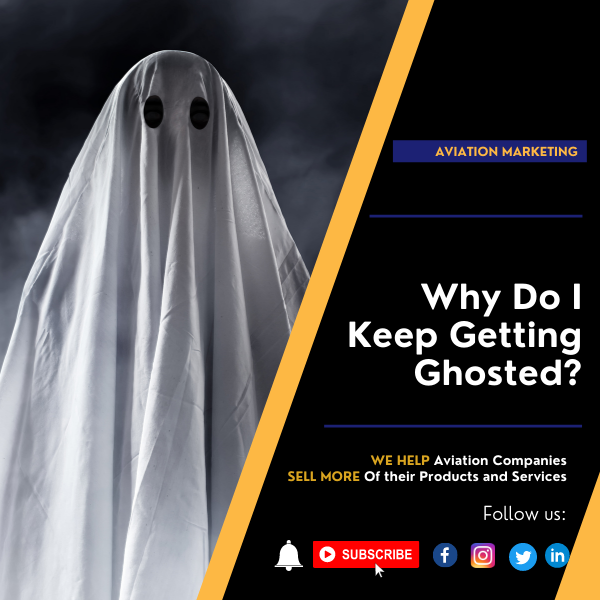Do aviation sales pros still use voicemail?
With all of the technological innovations in the ways that people communicate, is it even worth it for aviation salespeople even bother to leave a voice mail message?
The short answer is, yes.
The demographics of the aviation industry are what they are, it still makes sense to make phone calls, and since at least 70% of the time you’re going to reach a voice mail box. So, it makes sense to learn how to leave a good voice mail message.
And like anything else, if you’re going to do something, you’d better do it well!
[embedyt] https://www.youtube.com/watch?v=62aWjhddGeU[/embedyt]
[smart_track_player url=”http://traffic.libsyn.com/aviationmarketing/Voice_Mail_for_Podcast_.mp3″ background=”default” ]
Paula Williams: Welcome to this week’s episode. Today, we are talking about the ultimate voicemail outline.
John Williams: Yes.
Paula Williams: Yes, we all hate voicemail, don’t we?
 John Williams: Actually, nowadays I use it more, and more, not leaving messages, but because of all the calls that we’re not supposed to get because of do-not-call lists, et cetera. If I don’t recognize the number I just let it go to voicemail. If they don’t leave me one, c’est la vie.
John Williams: Actually, nowadays I use it more, and more, not leaving messages, but because of all the calls that we’re not supposed to get because of do-not-call lists, et cetera. If I don’t recognize the number I just let it go to voicemail. If they don’t leave me one, c’est la vie.
Paula Williams: You’re not talking to them. Right, exactly.
I’ve always thought leaving a voice mail was a waste of time.
And to be honest, when we … Actually, up until about a year ago, I almost never left voicemail because I thought it was a waste of time. I thought, “Nobody’s ever going to call me back from a voicemail,” right?
John Williams: Mm-hmm (affirmative).
Paula Williams: But I have changed my mind and will tell you why, okay? Some things just don’t lend themselves to three. So we’re going to get there, but this is going to be a five-sentence outline that you can use to create your own voicemail message that actually does work.
John Williams: So you’re giving something away.
Paula Williams: Exactly.
John Williams: So [inaudible 00:01:19].
Paula Williams: Well, it happens, you know. If people start doing better in the aviation industry, then they start being able to afford more of our products and services. Right?
John Williams: Of course.
Aviation sales pros traditionally use the phone a lot. Here’s what’s working against them.
 Paula Williams: So we share some of the things that we learned along the way, and this is one of them. So I’ll share my outline and you can use it, yourself. Okay. So first of all, what’s working against us?
Paula Williams: So we share some of the things that we learned along the way, and this is one of them. So I’ll share my outline and you can use it, yourself. Okay. So first of all, what’s working against us?
Spam and Robocalls
John Williams: Yeah. That phone spam, robocalls. Good night alive.
Paula Williams: Oh man. I don’t know if this is true all over the world, but in the United States it has gotten so out of hand. You know, I don’t even answer my phone anymore. I let everything roll to voicemail. I know you do too.
John Williams: Unless I’ve made an identifier on it so that I know who it is.
Paula Williams: Yeah. So if you recognize the number. But if you don’t recognize the number you never pick it up.
John Williams: No, and I go a step further. I actually block the call.
Paula Williams: Right.
You wouldn’t believe this, but actually, we get calls from numbers that are very similar, that have the same identifiers and everything else. The people that do these kind of spam calls have gotten really, really good at making a number of look familiar to you because it’ll have the same four last, or the same three first, or something.
John Williams: As a matter of fact, I got a call from myself.
Paula Williams: Oh my gosh.
John Williams: They they spammed my phone number and it kind of … I looked at it and it was me calling me. And I thought, “What?” And I went to block it, and I said, “No, wait a minute.” I said-
Paula Williams: “If I block myself …”
John Williams: … but I don’t call myself.
Paula Williams: Oh my gosh.
John Williams: So I can block my number. And I did.
Paula Williams: Okay, well, all right. So, good for you. However, obviously we’re up against quite a bit if we are on the other end of that and we are making calls in order to do business with people. Right?
John Williams: Exactly.
Phone Screening, Technology and Gatekeepers
Paula Williams: Okay. There is phone screening, and technology, and gatekeepers and we have a very nice set of people that answer our phone. We employ gatekeepers. Most people, I think, that are in business, that’s one of the first investments that they make, is who’s going to answer the phone and how are we going to keep from wasting our time on robocalls and spam?
John Williams: As a matter of fact, when you call our business number, you always get a person.
Paula Williams: Mm-hmm (affirmative). Human being.
John Williams: Unless it’s after hours.
Paula Williams: Right. If you call during business hours in mountain time, then you get a human being, and I really think that’s an important. It’s kind of beyond the scope of what we’re talking about today.
John Williams: No, well, I’m talking about phoning, and robocalls. I mean they stop them.
Paula Williams: Yeah, they do. And so they do the hanging up for us, which is nice, and, if they get a human, they do a really nice job of screening those calls and making sure that we get the ones that are important. And the ones that are obviously somebody that doesn’t know anything about us, that’s just randomly dialing numbers, we don’t bother with.
Fear of Making Sales Calls
And the third thing is that, I think even more than ever, salespeople hate making phone calls because of all of those things. Right.
John Williams: Yeah, at least. And then there’s another one: fear.
Paula Williams: And fear. Yeah. So I’m guilty as well. I seriously dislike the phone. I will do just about anything to avoid picking up the phone and calling. But it is so effective that I can’t not. Right?
John Williams: Yep.
Reasons calling prospects on the phone still works
 Paula Williams: It would be irresponsible for that to not be part of our sales strategy. Okay. So what’s working for us?
Paula Williams: It would be irresponsible for that to not be part of our sales strategy. Okay. So what’s working for us?
Demographics
In the aviation industry, as far as the decision makers go, demographics. If you want to be in the thought process of an aviation decision maker who is male, 45-plus, college educated, old school, chances are he is more likely to answer the phone than he is to … or at least to return a phone call, than he is to pick up an email, or open an email from somebody that he doesn’t know, or respond to an email.
John Williams: We should talk about emails another time.
Paula Williams: We will talk about emails another time. Same thing with social media. I mean, you can do the LinkedIn, you can do a lot of things, and we’ll talk about those, also, another time. And there’s a lot of LinkedIn spam, nowadays.
John Williams: Oh, heavens.
Paula Williams: Yeah. I mean, somebody has invented software that will let you spam your LinkedIn contacts and I think they need to be shot.
John Williams: Well, at least removed.
Paula Williams: Okay, fine. I’m not advocating murder in real life. But seriously, it’s, it has disintegrated the credibility of even the most credible of social networks-
John Williams: Yes, it has.
Paula Williams: … to the point where people are afraid to accept friend requests and they are afraid to open their LinkedIn messages. So a lot of people don’t even do that anymore.
Tradition
The other thing is tradition. I’ve actually had somebody say, “I didn’t think you were interested in doing business with us because you haven’t called me in a few months.”
“But I’ve been sending you email, and I’ve been sending you postcards, and I’ve been sending you stuff.” But people think that if you’re really interested in doing business with them, you will give them a call every once in a while. That’s what good salespeople do, right?
John Williams: Evidently.
No Competition
Paula Williams: Evidently. Exactly. And the third thing is that your competitors have left the field. A lot of times, they will use the newer tools rather than the older ones. They have shiny-object syndrome. They will invest all of their time and money into something that is easier, and cooler, and neater, and more modern, and everything else, that doesn’t work, right?
John Williams: That’s right. That doesn’t work. I’m glad you added that.
Paula Williams: Exactly. But it looks good, and has good statistics and everything else. But as far as when it comes down to sales the phone really is a very necessary part of this equation, as much as I wish it wasn’t.
The problem – prospects are incredibly busy and almost never actually answer the phone.
 Okay. So here’s the problem. This is your prospect, right? He’s there and he’s gone. And if you didn’t see that, that was the Tasmanian Devil of Looney Tunes fame. And I hope we don’t get into copyright trouble, but if we do, my apologies. But he has the best example that I can think of, of the type of prospect that we’re talking about.
Okay. So here’s the problem. This is your prospect, right? He’s there and he’s gone. And if you didn’t see that, that was the Tasmanian Devil of Looney Tunes fame. And I hope we don’t get into copyright trouble, but if we do, my apologies. But he has the best example that I can think of, of the type of prospect that we’re talking about.
They are super busy. I had a lady that I worked with at a bank who was like this, and actually, I was her direct report. And she was so hard to get ahold of, and she was so hard to work with, I would actually have to plan a way to get her attention in order to get a decision on anything, and so on.
How to Talk to a Human Tornado
And so I’ve applied that to what we do now. So how to talk to a human tornado.
Number one, get in its way. Whatever it’s doing all day, you want to be in the way of that. If it’s somebody who’s on the phone all day, you need to be in their way. With this person, I would actually … I knew when she was likely to leave her office to go to lunch, or to go to a meeting, or whatever, and I would literally stand there, with my clipboard in hand, saying, “I need four decisions and three opinions before I can proceed on my projects.” And she’d say, “Walk with me.”
And so we would walk, and I would, very concisely, ask her what I needed to ask her, and she would give me the answers that I needed. And that was the way that we did it.
John Williams: Because if you weren’t concise, she would say …
Paula Williams: “This is not interesting to me,” and she would walk in the other direction.
Anyway, I’d lose her entirely, so I needed to start with, “Here are the reasons that it is in your best interest. to listen to me. These are things that are going to be delayed if I don’t have some input right now.”
And if you’re talking to somebody that you’re trying to sell something to, you need to give them a reason to listen. So, “Many of my clients are losing money because of these things.” And, “Many people with businesses like yours are losing money, or are spending too much, or are neglecting an opportunity because …” So you need to give them a reason that resonates with them. Put yourself in their shoes and say, “Why, when I am so busy, should I take the time to listen to you?”
John Williams: Yeah. It has to resonate with them. It’s not a good reason to you.
Don’t take it personally!
Paula Williams: Exactly. And the third thing is to not take it personally. So if you have a situation where they just run on by and you didn’t even get the opportunity to talk to them, you don’t take it personally. You get your hard hat on. If you get knocked over, that’s okay. They didn’t mean it. And you just go do that again the next day. You have to be persistent, and everything else, because it’s not personal. They are just a force of nature. They don’t care about you. And they shouldn’t, because they’re running a business and they’re busy.
So you have to give them a reason, and you have to come up with a different reason if that one didn’t work, and you have to keep trying. These things happen. Right?
John Williams: Absolutely. We used to have a slide that we’d used, that said, “It takes …” I don’t remember the number.
Paula Williams: 20-plus.
John Williams: “… 20-plus contacts to make a sale.”
Paula Williams: Right, exactly. And sometimes, just to get a foot in the door, it takes multiple contacts and the phone should be among the ways that you’re doing this. And you shouldn’t do a phone call every day unless you’re really … actually, that might work.
John Williams: And then they had, “Most salespeople gave up after the third …”
Paula Williams: Yeah.
John Williams: I don’t know, “… second or third call.”
Paula Williams: Mm-hmm (affirmative).
John Williams: And, “… most sales happen after the 12th or 15th call.”
Paula Williams: Right. That’s true. And so you may not be making any progress with the first three or four calls. These things happen. What I do is, if I don’t get a response or if I get a non-committal or no progress from a first call, then I will send something else. I’ll send a postcard or something like that, and then I’ll try again.
But a lot of people will just persist by phone, and if you don’t have any money that’s your only option, is to to use the phone. These things happen. Okay, that’s how you talk to a human tornado.
Five Sentence Voice Mail Outline
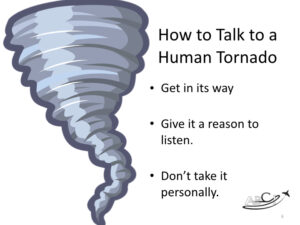 Okay, here’s our five-sentence outline and this is what you say when you’re in the path of the tornado. And you have to have rehearsed this, I swear, because if you don’t you’re going to be distracted by the flying cows, right?
Okay, here’s our five-sentence outline and this is what you say when you’re in the path of the tornado. And you have to have rehearsed this, I swear, because if you don’t you’re going to be distracted by the flying cows, right?
I kid you not. Okay.
So, “Hi Taz. This is Paula Williams, from ABCI”
See, Taz, meaning the tornado, right?
John Williams: Okay.
Paula Williams: “I saw your ad in the NBAA magazine and I see that you’re an MRO shop in Tucson. I’m calling because I provide insurance to aviation companies in this area, and I found that, in my experience, that there are three mistakes that Part 145 owners make, that caused them to overpay, or be underinsured.
“Please give me a call at (702) 987-1679, or look for my email. Let’s sit down for 20-minute conversation. I’d also like to learn more about your business so I can make intelligent referrals.
“Talk to you soon.”
Okay, so that was a five-sentence outline. Hopefully you were listening. I didn’t tell you to be listening for those five things.
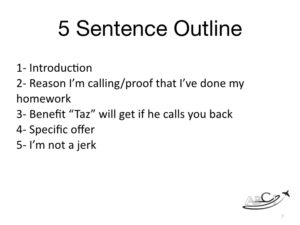 John Williams: Well, the fact that they’re here, they’re listening.
John Williams: Well, the fact that they’re here, they’re listening.
Paula Williams: Exactly. So the five-sentence outline: we gave an introduction, a reason I’m calling, and proof that I’ve done my homework, right?
John Williams: Mm-hmm (affirmative).
Paula Williams: So I know they had an ad in the NBAA magazine. I know they are Part 145 organization in Tucson.
Here is the benefit that Taz will get if he calls me back. He’ll find out about the three ways that his competitors likely are overpaying, or whatever, and ways that he can prevent that. There’s a specific offer, a consultation, and five, “I’m not a jerk, I’m interested in your business. I want to be able to make referrals.”
So, introduction, reason I’m calling, proof I’ve done my homework, benefit Taz, what is the benefit to Taz if he calls you back? Number four, the specific offer, and number five, “I am not a jerk.”
Okay. That’s a lot to get into a 30-second phone call. So now you’re going to time me.
John Williams: I am?
Paula Williams: Yes you are.
John Williams: I guess I am.
Paula Williams: Okay. And we are going to do this one more time, and you, our studio audience, are going to listen to those five elements in 30 seconds, right?
John Williams: Okay. I actually have a [inaudible 00:14:14] timer.
Paula Williams: Of course you do. So tell me when.
John Williams: When.
Timed example voice mail message
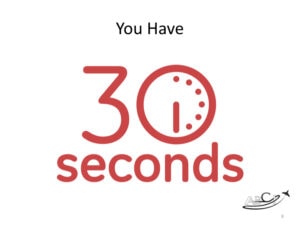 Paula Williams: “Hi Taz. This is Paula Williams, from ABCI. I saw your ad in the NBAA magazine and I see that you’re an MRO shop in Tucson. I’m calling because I provide insurance to aviation companies in this area and I have found, in my experience, that there are three mistakes that Part 145 owners make that will cause them to overpay or to be underinsured.
Paula Williams: “Hi Taz. This is Paula Williams, from ABCI. I saw your ad in the NBAA magazine and I see that you’re an MRO shop in Tucson. I’m calling because I provide insurance to aviation companies in this area and I have found, in my experience, that there are three mistakes that Part 145 owners make that will cause them to overpay or to be underinsured.
“Please give me a call at (702) 987-1679 or look for my email. Let’s sit down for a 20-minute conversation. I’d also like to learn more about your business so that I can make intelligent referrals.
“Talk to you soon.”
John Williams: 32 seconds.
Paula Williams: 32 seconds. Okay, I went over. We’re shooting for 30. I did fumble a little bit. I did not rehearse this as much as I could have. Most machines will do either a 30 or a 45 second message, right?
John Williams: Yes. And then they’ll cut you off.
Paula Williams: Yeah, exactly. So you want to make sure that you can get it in under 30 seconds, so I’ve got a little bit of work to do. That was not perfect, but it was pretty close and I probably could’ve gotten it in under 30 seconds if I had done a little bit more rehearsing. Right?
John Williams: Oh, I believe it.
Paula Williams: Okay. All right. So did you hear those five sections?
John Williams: Yes.
Paula Williams: Introduction, reason I’m calling and evidence that I’ve done my homework, benefit Taz will get if he calls me back, specific offer, and “I’m not a jerk.”
John Williams: Yep.
Paula Williams: Okay, cool. All right. The other thing that I said, you may have noticed, in this message was, “I’m also going to send you an email.”
John Williams: True.
Revenge of the Voicemail Transcript
 Paula Williams: Okay. One of the biggest problems with voicemail, a lot of times it will do a transcript, well or badly, of what you just said, so you want to make sure that you enunciate clearly. So if it gives him a transcript, and if that’s the way that he’s reviewing it, it makes sense.
Paula Williams: Okay. One of the biggest problems with voicemail, a lot of times it will do a transcript, well or badly, of what you just said, so you want to make sure that you enunciate clearly. So if it gives him a transcript, and if that’s the way that he’s reviewing it, it makes sense.
But sometimes they get the phone number wrong. Sometimes things go awry, whatever, so you also want to send an email with the bones of what we just talked about with those five sentences. Send them an email right after you left the voicemail.
Now, if he’s like John, and heard the ding, then he may listen to the phone call, he may check his email, those kinds of things. It may have gotten his attention anyway, even though he didn’t pick up, right?
John Williams: Could be.
Paula Williams: Right. So then it gives him two options to respond. He can either pick up the phone and call you back if he’s a phone-type guy, like John, or he can respond to the email if he happens to be an email-type person, like me.
Right?
John Williams: True.
Paula Williams: Okay. So then it gives your customer, or your potential customer, two options to call you back.
John Williams: That’s right.
The Holding Pattern
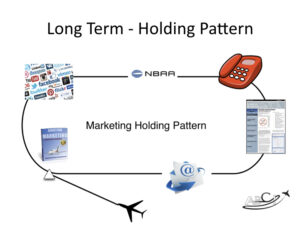 Paula Williams: Right. Now, last week we talked about a holding pattern and how important it is, and these phone calls are just one of many things that you should be doing with people who are in your pipeline. And hopefully you’re also sending them newsletters; people listen to our podcast, we send them episodes; sending them emails; sending them books, or calendars, or Christmas cards, or whatever; connecting with them on Facebook, LinkedIn, Twitter, Instagram, wherever they happen to be; and meeting with them at NBAA, or whatever convention it is that you happen to go to.
Paula Williams: Right. Now, last week we talked about a holding pattern and how important it is, and these phone calls are just one of many things that you should be doing with people who are in your pipeline. And hopefully you’re also sending them newsletters; people listen to our podcast, we send them episodes; sending them emails; sending them books, or calendars, or Christmas cards, or whatever; connecting with them on Facebook, LinkedIn, Twitter, Instagram, wherever they happen to be; and meeting with them at NBAA, or whatever convention it is that you happen to go to.
Those are all super important. And this is just one component of many, but it’s often your most powerful component because that’s the one that gets the best response, right?
John Williams: Absolutely.
Paula Williams: It’s also the most expensive in terms of people time. So you may want to focus on just those hundred people who are the most likely to be good customers for you when you’re talking about making phone calls. You’re not going to be making thousands of them. You might be focusing on the top 10 or a top hundred during this particular month, and then replace them next month with new people, or whatever your strategy happens to be.
How often should you call back?
But I would call more than once. If you don’t get a response, try again. Try up to three times, at least, and carry on with that. And then, I also try-
 John Williams: Not three times the same day.
John Williams: Not three times the same day.
Paula Williams: No, not three times the same day.
John Williams: Or the same week.
Paula Williams: Or the same week. Exactly. So you might want to leave a week, week and a half, between calls.
John Williams: Unless you don’t leave a voicemail.
Paula Williams: Right.
John Williams: If you don’t leave a voicemail then you can call as many times you want in the day.
Paula Williams: No, you can’t, because they’ll think you’re a stalker. They’re going to see that number multiple times, and they’re going to go, “What the heck, and they’re going to block you.”
John Williams: Unless they have a receptionist.
Paula Williams: Unless they have a receptionist. Yeah. And then, if you can make friends with the receptionist … and that’s a whole another strategy where you get in good with the receptionist and make her understand that she is doing her boss a favor by making sure that he understands the importance of your call. But-
John Williams: Her or him.
Paula Williams: Her or him. Yes. In both cases we’re not assuming that the receptionist is a woman, and we are not assuming that the boss is a guy, but, demographically speaking, sometimes that’s the way it works, so anyway …
There’s lots of ways of managing this, but being able to leave a really good voicemail is a very key skill nowadays, and it wasn’t necessarily … I think a year ago we were advising people not to even leave voicemails.
John Williams: Yes, times change. You have to be flexible.
Paula Williams: Exactly. We were just saying, “If you don’t get somebody call back.” Now, you’re never going to get somebody so that you might as well use voicemail.
Okay. So to keep up with these things as they’re changing and to be up on what’s working for people, and what’s not, we have a group of people that interacts in a private Facebook group.
Our Aviation Marketing Lab
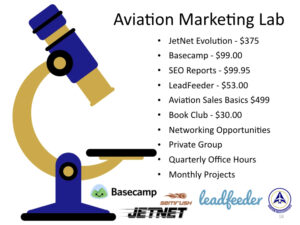 We share tips and tricks with aviation sales pros, we share what’s working, we celebrate each other’s successes, and we share tools in a way that really makes them cost effective for everyone. Including some of the tools that will help you get the data that you need, and get the training you need, and the skills, and everything else, to do really good sales and marketing.
We share tips and tricks with aviation sales pros, we share what’s working, we celebrate each other’s successes, and we share tools in a way that really makes them cost effective for everyone. Including some of the tools that will help you get the data that you need, and get the training you need, and the skills, and everything else, to do really good sales and marketing.
John Williams: Together with all the tools. And then you talk with us, and she can give you excellent marketing advice.
Paula Williams: Why, thank you. But it is actually over $1,000 worth of tools, and training, and consulting, and everything else, for $279 a month, so that is the very best deal that we could possibly make for small companies.
And we really do want people in the aviation industry to succeed because it is a small world and the better we all do, the better we all do, and the more money you have to spend on us and our services, and things like that. So it is not all altruism, but we do really enjoy working with people in this industry.
John Williams: Yes.
Paula Williams: So join our lab and we’d love to have you. Thank you for joining us and we’ll see you soon.
John Williams: See you next time!


